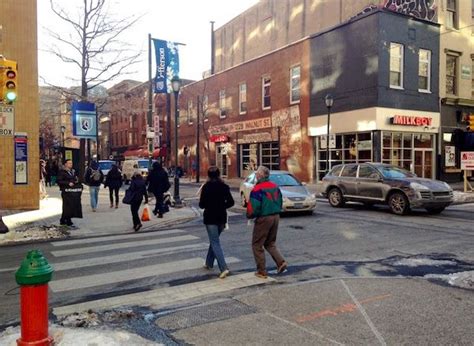Philadelphia, the City of Brotherly Love, has long grappled with issues of crime and violence. While certain areas of the city are generally considered safer than others, there are pockets of high crime that pose a significant threat to residents and visitors alike. This article will delve into the most dangerous part of Philadelphia, providing an in-depth analysis of the factors contributing to its high crime rate and offering insights into the challenges faced by law enforcement and community members alike.

The Most Dangerous Neighborhoods in Philadelphia
According to data from the Philadelphia Police Department, the most dangerous neighborhoods in the city based on crime rate per 100,000 residents are:
| Rank | Neighborhood | Crime Rate |
|---|---|---|
| 1 | Kensington | 2,150.8 |
| 2 | Strawberry Mansion | 2,067.3 |
| 3 | Nicetown-Tioga | 2,035.7 |
| 4 | Hunting Park | 1,972.8 |
| 5 | Frankford | 1,953.6 |
These neighborhoods are plagued by high levels of violent crime, including homicides, aggravated assaults, and robberies. In addition, they often suffer from poverty, unemployment, and a lack of access to resources.
Factors Contributing to Crime
The high crime rate in the most dangerous part of Philadelphia is influenced by a complex interplay of factors, including:
- Poverty and Inequality: The neighborhoods with the highest crime rates are also the poorest in the city. Poverty leads to a lack of opportunities, limited access to education and job training, and increased social isolation, all of which can contribute to criminal activity.
- Drug Use and Trafficking: The illegal drug trade is a major driver of crime in Philadelphia. Drug-related violence, including turf wars and disputes over profits, is rampant in high-crime neighborhoods.
- Gang Activity: Gangs play a significant role in organized crime in Philadelphia. They engage in a wide range of illegal activities, including drug trafficking, extortion, and violence.
- Lack of Police Presence: The Philadelphia Police Department faces chronic understaffing, which can lead to a lack of police presence in high-crime neighborhoods. This lack of visibility can embolden criminals and make residents feel less safe.
The Impact of Crime on Philadelphia
The high crime rate in Philadelphia has a profound impact on the city and its residents:
- Fear and Intimidation: Residents of high-crime neighborhoods live in constant fear of becoming victims of violence. This fear can limit their ability to go about their daily lives, access education and employment opportunities, and participate in community activities.
- Community Breakdown: Crime can tear apart communities. High levels of violence lead to mistrust, suspicion, and a breakdown in social cohesion. This can make it difficult for residents to work together to address crime and other community problems.
- Economic Loss: Crime has a significant economic impact on Philadelphia. The city spends millions of dollars each year on law enforcement, healthcare, and other services related to crime. This money could be better spent on other essential services, such as education and infrastructure.
Challenges Faced by Law Enforcement
Law enforcement faces a number of challenges in addressing crime in Philadelphia:
- Limited Resources: The Philadelphia Police Department is chronically understaffed and underfunded. This makes it difficult for officers to adequately patrol high-crime neighborhoods and investigate crimes efficiently.
- Community Mistrust: In some Philadelphia neighborhoods, there is a significant level of mistrust between residents and the police. This can make it difficult for police officers to build relationships with the community and gather information about criminal activity.
- Changing Crime Trends: Crime is constantly evolving, and law enforcement must adapt to new challenges. For example, the rise of social media and the proliferation of illegal firearms have made it more difficult for police to prevent and investigate certain types of crimes.
Community Responses to Crime
In addition to law enforcement efforts, community members are also playing a vital role in addressing crime in Philadelphia:
- Community Policing: Community policing initiatives aim to build relationships between police officers and residents. Officers patrol neighborhoods on foot, attend community meetings, and work with residents to identify and address crime problems.
- Neighborhood Watch Programs: Neighborhood watch programs encourage residents to look out for their neighbors and report suspicious activity to the police. These programs can help create a sense of community and make it more difficult for criminals to operate.
- Youth Programs: Youth programs provide opportunities for young people to participate in positive activities and develop life skills. These programs can help keep youth off the streets and away from gangs and criminal activity.
Common Mistakes to Avoid
When addressing crime in Philadelphia, it is important to avoid the following common mistakes:
- Ignoring the Root Causes: Focusing solely on law enforcement without addressing the underlying social and economic factors that contribute to crime is ineffective.
- Reliance on Mass Incarceration: Mass incarceration has failed to reduce crime rates and has had a devastating impact on communities of color.
- Ignoring Community Input: Law enforcement and policymakers must work with community members to identify and address crime problems. Ignoring the input of those most affected by crime is counterproductive.
Conclusion
The most dangerous part of Philadelphia is a complex and challenging issue. High levels of crime have a profound impact on residents, law enforcement, and the city as a whole. A comprehensive approach is needed to address the root causes of crime, support law enforcement, and empower community members. By working together, Philadelphia can create a safer and more just city for all.
